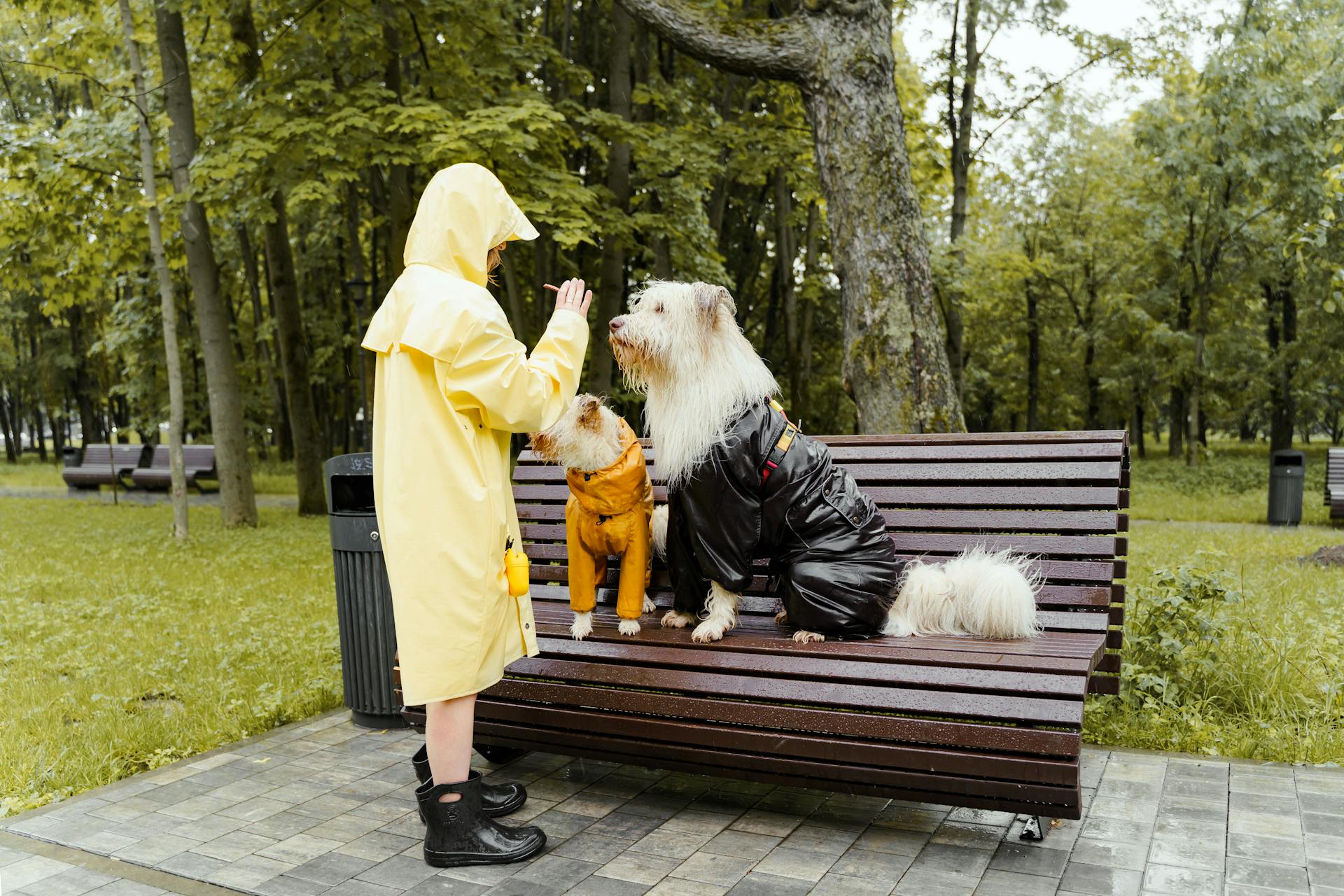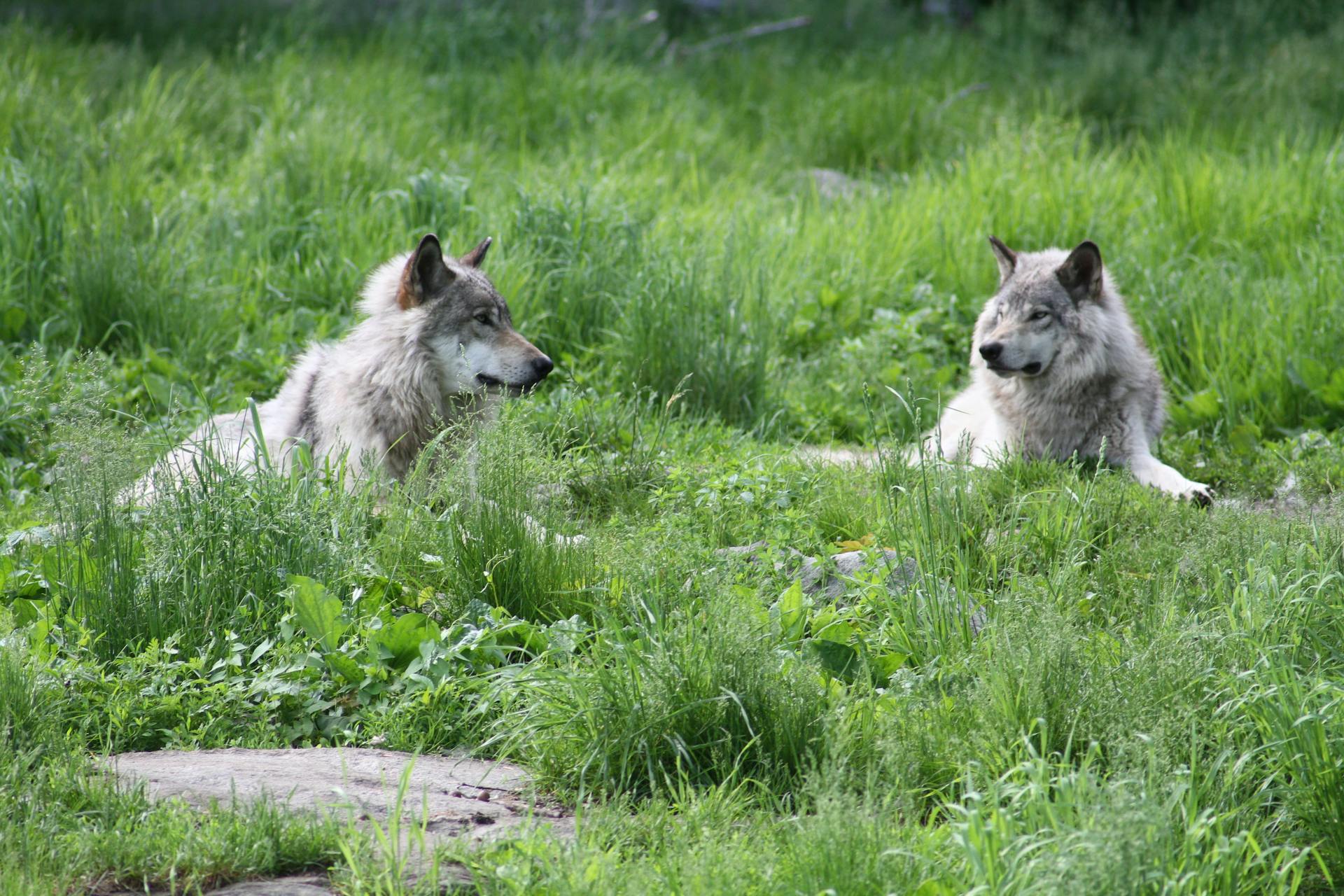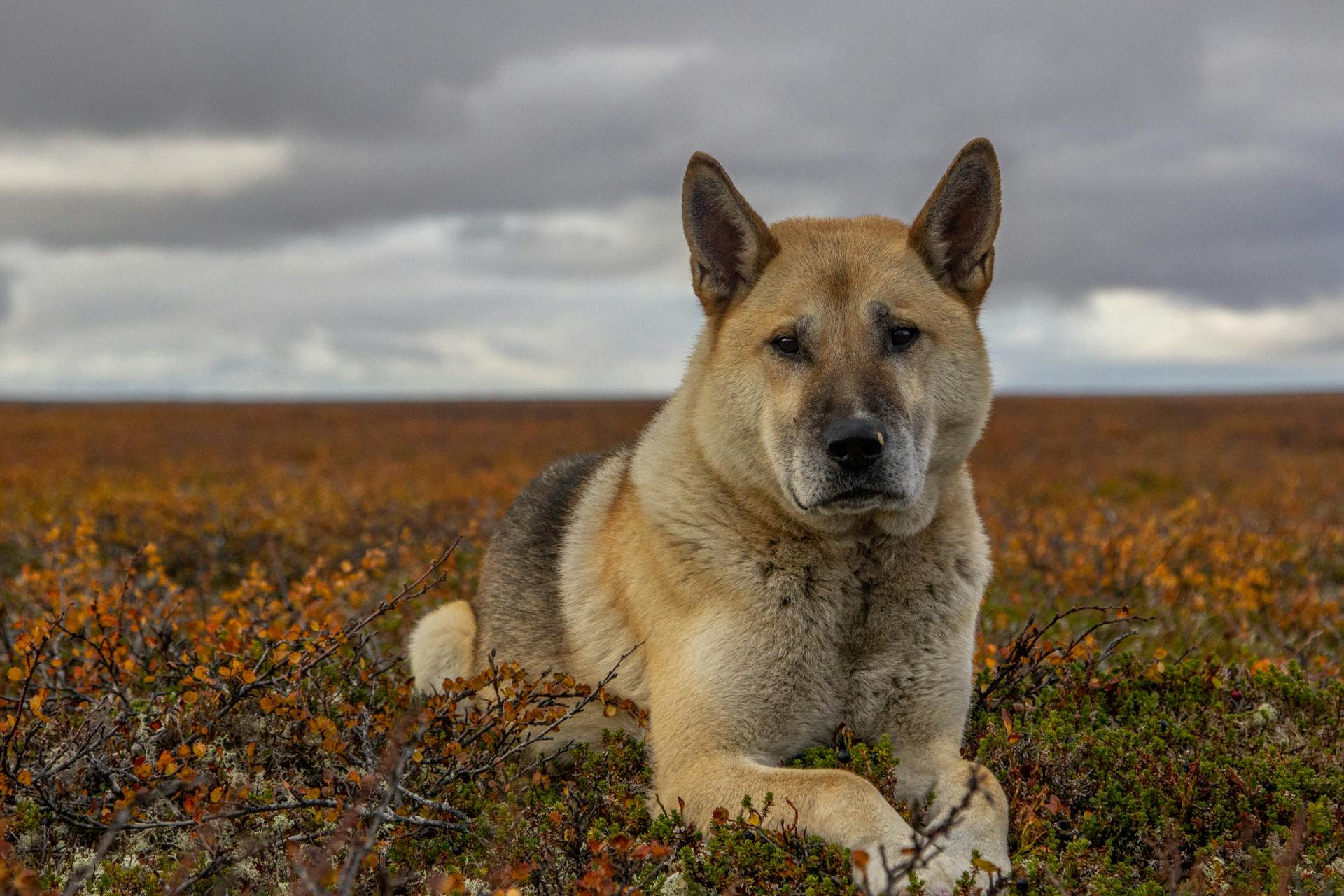
Reverse sneezing in dogs can be alarming, but it's usually not a cause for concern. However, in some cases, it can lead to more serious issues.
Dogs can experience reverse sneezing due to an elongated soft palate, which can cause their airways to become blocked. This blockage can lead to a range of symptoms, including rapid breathing, a blue-tinged tongue, and even collapse.
Most cases of reverse sneezing in dogs can be treated at home with some simple remedies. However, if your dog is experiencing severe symptoms or has a history of respiratory issues, it's best to consult with a veterinarian for proper guidance.
What Is Reverse Sneezing in Dogs?
Reverse sneezing in dogs is a condition that causes the dog to rapidly pull air in through the nose, producing a loud snorting sound that can be alarming for pet parents.
This condition is also known as paroxysmal respiration, and it's characterized by a loud snorting noise that sounds like the dog is trying to take a deep breath in while sneezing at the same time.
A dog in the midst of a reverse sneezing episode will typically raise its head and extend its neck, making the snorting noise. Most episodes last less than a minute, but they can be frightening for both pet parents and pets.
In some cases, dogs may also begin to reverse sneeze when they're over-excited.
Causes and Symptoms
Reverse sneezing in dogs can be caused by a variety of factors, including allergies to pollen and plants, nasal mites, and long snouts. Allergies are a common trigger for reverse sneezing episodes.
Dogs with long snouts are more prone to developing reverse sneezing than other dogs. Any dog can potentially suffer from this problem, either once or as part of a chronic reverse sneezing condition.
Symptoms of reverse sneezing include gasping, difficulty drawing air, an extended neck, and snorting. These symptoms usually clear up within about one to two minutes, with no ill effects.
The most common symptoms of reverse sneezing are:
- Gasping
- Difficulty drawing air
- Extended neck
- Snorting
Other conditions, like tracheal collapse, can appear similar to reverse sneezing but may also exhibit additional symptoms such as exercise intolerance and a bluish tinge to the gums and other mucous membranes.
What Happens When a Dog Sneezes?
A dog sneezes by rapidly expelling air from the lungs, often accompanied by a loud noise. This sudden release of air can be startling, especially if you're not expecting it.
Dogs sneeze to clear irritants from their nasal passages, such as dust, pollen, or even their own hair. A sneeze can be a normal response to an irritant.
Some dogs sneeze more frequently than others, particularly those with allergies or sensitive noses. If your dog is sneezing excessively, it's worth investigating the underlying cause.
Dogs can also sneeze due to a reverse sneeze, which is a separate issue that sounds more like a snort than a traditional sneeze.
Related reading: Tracheal Collapse vs Reverse Sneezing
Causes of Canine Illnesses
Reverse sneezing in dogs can be caused by a variety of factors, including allergies to pollen and plants, which can trigger an episode of reverse sneezing instead of a normal sneeze. Nasal mites can also contribute to this condition.
Dogs with long snouts are more prone to developing reverse sneezing, but any dog can suffer from it. It's essential to rule out severe underlying conditions such as collapsing trachea, nasal tumors, or other similar problems.
Some common irritants that can lead to reverse sneezing include eating or drinking too fast, foreign bodies, pressure on the throat, viruses, and mites. These irritants can cause a spasm of the throat and nasal passages, leading to a reverse sneezing episode.
Here are some potential causes of reverse sneezing in dogs:
- Allergies
- Eating or drinking too fast
- Foreign bodies
- Mites
- Pressure on throat (often from pulling on leash)
- Viruses
Dogs with elongated soft palates, especially brachycephalic breeds, may be more susceptible to reverse sneezing due to irritation in the soft palate. Other external issues that can cause irritation include reactions to household products and fragrances, and intolerances to exercise.
Symptoms in Dogs
Reverse sneezing in dogs can appear alarming, but it's usually just a temporary issue. Symptoms during an episode include gasping, difficulty drawing air, an extended neck, and a loud snorting sound.
A dog's elbows are often turned out and their eyes bulge as they struggle to get air into the lungs due to the narrowing of the trachea. These symptoms usually clear up within a minute or two, with no long-term effects.
Some common symptoms of reverse sneezing in dogs include:
- Gasping
- Difficulty drawing air
- Extended neck
- Snorting
However, if your dog is experiencing reverse sneezing on a regular basis, it's essential to visit the veterinarian to rule out other conditions, such as tracheal collapse.
What Does Sound Like?
The sound of reverse sneezing can be a bit unsettling if you've never heard it before. It's often compared to a loud, nasal snorting or honking, similar to a goose.
The noise can be quite loud and may catch you off guard, but it's usually not a cause for concern. It's simply your dog's way of unblocking their trachea.
Reverse sneezing typically lasts only up to 30 seconds, so it's usually a short-lived issue. However, if your dog is experiencing repeated episodes, it could be a sign of a more serious problem.
Helping Your Dog
If your dog is dealing with reverse sneezing, it's essential to stay calm and upbeat to help ease their anxiety and stress. Gentle petting can also help soothe your dog during an episode, but be sure not to pet their face or snout.
Most reverse sneezing episodes will pass on their own within a minute or so, but if it's your dog's first time experiencing one, it's a good idea to take them to the vet to rule out other conditions.
If your vet diagnoses your dog with reverse sneezing, you can try a few things to help ease their episodes, such as gently lifting their head up and then down, or distracting them with a toy or treat.
Some common remedies for reverse sneezing include holding your dog's nostrils closed for a second, lightly massaging their throat, or trying to calm them down verbally.
Here are some things you can try to help your dog during a reverse sneezing episode:
- Hold their nostrils closed for a second
- Lightly massage their throat
- Try to calm them down verbally
- Gently lift their head up and then down
- Distract them with a toy or treat
Keep in mind that most dogs don't require medication for reverse sneezing, but your vet may recommend antihistamines if the problem is serious, chronic, and allergy-related.
Diagnosis and Treatment
Reverse sneezing in dogs can be a concerning issue, but fortunately, it's usually harmless. A veterinarian will perform a physical examination, check the nasal passages, mouth, and throat areas, and may use a rhinoscopy to look for underlying causes such as mites, polyps, or tumors.
To confirm the diagnosis, the vet may take a sample from the nasal passages for biopsy to rule out nasal cancer. They will also ask about the duration and frequency of symptoms, as well as any concurrent medications the dog is taking.
Treatment typically involves addressing any underlying causes such as allergies or mites. If the reverse sneezing is idiopathic, it may not require treatment. In some cases, antihistamines may be prescribed to ease allergic reactions, and polyps or growths may need to be removed to allow for easier breathing.
Diagnosis of Dogs
If your dog's reverse sneezing symptoms are concerning, a veterinarian will need to perform several tests to rule out underlying causes. These tests may include a physical examination, rhinoscopy, and nasal passage biopsy.
A veterinarian will thoroughly check the nasal passages, mouth, and throat areas during the physical examination. This is to ensure there are no mites, polyps, or tumors present.
A rhinoscopy, which uses a speculum to examine the nasal passages more closely, may be performed to gather more information. This can help identify any potential issues.
A sample from the nasal passages may be taken for biopsy to rule out nasal cancer. This is an important step in determining the underlying cause of your dog's symptoms.
Your veterinarian will also ask about the duration and frequency of your dog's symptoms, as well as any concurrent medications they're taking. They may also request a video recording of an episode to assist in the diagnosis.
If your dog is displaying any of the following symptoms, it's essential to consult with a veterinarian right away:
- Labored breathing
- Ongoing, consistent cough
- Frequent wheezing
- Panting without exercise
- Open-mouthed breathing
- Lethargy
- Lack of interest in exercise
- Pale or blue gums
Dogs: Treatment
If your dog's reverse sneezing is caused by an underlying condition such as allergies or mites, addressing that condition is crucial to reducing the frequency and intensity of the episodes.
You can try easing allergic reactions with antihistamines, and removing polyps or growths to allow for easier breathing. If the reverse sneezing is idiopathic, meaning the cause is unknown, treatment may not be necessary.
To help shorten the duration of an attack, try channeling the air through your dog's mouth rather than their spasming nasal passages. This can be done by closing off the nostrils with your hand for a few seconds and allowing your dog to breathe through their mouth instead.
Pet insurance can help cover the cost of treating your dog's symptoms, so it's a good idea to get a quote from top pet insurance providers.
Some home remedies you can try to help your dog get over the irritation include verbally calming them down, placing them outside or somewhere with access to fresh, cool air, and gently massaging their throat to help the irritation pass.
If your dog has a bout of reverse sneezing that's not caused by allergies, you can also try blowing very lightly on their face, which may cause them to sneeze. However, in most cases dogs will quickly get over their bout of reverse sneezing with no need for intervention.
Here are some signs that may point to an underlying health problem:
- Labored breathing
- Ongoing, consistent cough
- Frequent wheezing
- Panting without exercise
- Open-mouthed breathing
- Lethargy
- Lack of interest in exercise
- Pale or blue gums
If your dog is displaying any of these symptoms, it's essential to have them examined by your veterinarian to determine the right diagnosis.
Frequently Asked Questions
What can be mistaken for reverse sneezing in dogs?
Reverse sneezing in dogs can be mistaken for respiratory distress, coughing, or choking, making it essential to identify the correct cause of symptoms. If you suspect your dog is experiencing a reverse sneeze, it's crucial to seek veterinary attention to rule out other serious conditions.
How much reverse sneezing is too much?
Recurring or severe reverse sneezing episodes can be a sign of an underlying issue, so consult a vet if your dog's episodes are frequent or interfere with their breathing
Can reverse sneezing make dog pass out?
No, reverse sneezing is not life-threatening and does not cause dogs to pass out. However, if your dog experiences frequent or severe episodes, it's best to consult with a veterinarian to rule out any underlying health issues
What is the difference between a collapsed trachea and a reverse sneeze?
A reverse sneeze produces a loud snorting sound, while a collapsed trachea makes a distinct "honking" sound, often heard in toy breeds. Understanding the difference is crucial for proper diagnosis and treatment of these two distinct respiratory conditions.
Sources
- https://lakecityanimalhospital.com/blog/reverse-sneezing-in-dogs-causes-and-what-to-do/
- https://www.berkeleydogandcat.com/site/blog/2022/05/15/dog-reverse-sneeze
- https://www.akc.org/expert-advice/health/what-happens-when-a-dog-reverse-sneezes/
- https://wagwalking.com/condition/reverse-sneezing
- https://fotp.com/learn/dog-health/reverse-sneezing-what-is-it-and-why-do-dogs-do-it
Featured Images: pexels.com


